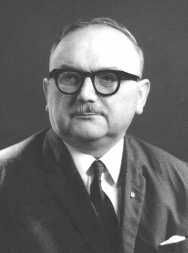 Volodymyr Shayan
Union of the Believers of the Ukrainian Native Faith

Union of the Believers of the Ukrainian Native Faith

Ridnoviry (Native faith believers), Yazychnyky (heathens)

Volodymyr Shayan (1908-1974)

Halyna Lozko (Zoreslava)

Ukraine (1934)

Kyiv, Ukraine

Velesova Knyga (Veles Book), Vira Predkiv Nashyh (The Belief of Our Ancestors) – V. Shayan, Volkhovnyk, Pravoslov (the prayer-book)

Svaroh

An attempt to revive pre-Christian Slavic neopaganism. Promotes worship of the pantheon of ancient deities. Volodymyr Shayan presented studies about God as a multi-personal being that manifests in multiple ways and under numerous names (about 130). The Union considers these studies as the basis of theological-philosophical comprehension of the Ukrainian ethnic faith. At the core of their worship is a teaching about Tryglav (the notion derives from description of three-headed being). Tryglav is not a name of a certain god, but notion of the unity of three greatest deities—Svaroh, Perun and Svitovyt. The Union adheres to a ritual calendar of the old pre-Christian festivals.

Followers (called “Ridnoviry”) consider Velesova Knyga—an old Slavic work, the text of which was scorched on small wooden planks—to be their Holy Scripture. Its authorship is ascribed to Slavic soothsayers and is said to date to the 9th century AD. According to the group’s followers, the small planks with ancient texts were discovered in Velyki Burluk (Kharkiv region, Ukraine) in 1919 by A. Izenbek, a White Army colonel who later took them to Brussels. The first acquaintance with planks was begun in Brussels in 1925 by Y. Mirolyubov who, it is said, processed the inscriptions over the course of 15 years. The first texts were published in the Netherlands (1972, 1975) and later reprinted in Russia (1990). After the colonel’s death in 1941, the actual planks disappeared, and their location is currently unknown. The sole remaining evidence consists of written copies and a photo of one small plank, taken by Mirolyubov. Most academic researchers—historians and linguists—regard this book as a fabrication, written in 19th or 20th century AD, which unsuccessfully imitates an ancient Slavic language.

Followers preach that international and (even more so) interracial marriages are forbidden, on the basis that such unions destroy the soul and its connection with native gods and ancestors.

Canada, Ukraine, United States

Ukrainian

www.risu.org.ua/eng/major.religions/paganism
en.wikipedia.org/wiki/Ukrainian_neopaganism#Ukraine
www.wcer.org/members/europe/ukraine/index.htm
vinland.org/heathen/pagancee/#Ukraine

www.svarga.kiev.ua
www.svaroh.info/svar-eng.html
www.viche-info.com
|